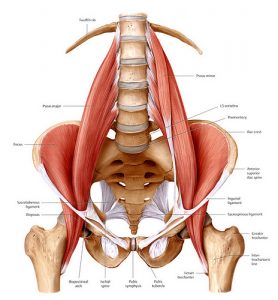
The muscles of the hip often play a primary role in the health of your lower back. Your upper leg or thigh bone is called the femur, and it is controlled by the hip Flexors and hip Extensors. Your hip flexors, mainly the iliopsoas (“psoas” for short), raise the leg towards your belly. Hip extensors like the gluteus and hamstrings move the femur away from your belly, kicking the leg behind you.
Most athlete stretch their hamstrings and quads and neglect their psoas. Especially if your main job is desk based, or you do a sport with a lot of squats or powerful leg plyometrics, you are at risk hypertonic, constricted, dysfunctional, and painful psoas muscles.
To take care of your psoas make sure you include exercises for the glutes and hamtrings in your workout, and stretches for the psoas. Some great hip stretches are the “death stretch”, the “bulgarian squat hold” and the “elevated pigeon pose”. For a really deep rewiring of your psoas book a deep tissue sports massage treatment to target that area. Be aware that to access the psoas, the therapist will need to put pressure on your abdomen and the attachments in and near your belly and inside thigh. Be sure you don’t eat a heavy meal just prior to your treatment or it could be uncomfortable!
Having tight or weak hips is also a major cause of anterior knee pain. Stretching and strengthening the hips can alleviate knee pain, especially if you are a runner. Check out this review of cross country runners: “High school cross country runners with weaker hip abductor, knee extensor and flexor muscle strength had a higher incidence of AKP (Anterior knee pain). Increasing hip and knee muscle strength may reduce the likelihood of AKP in high school cross country runners.”
Take care of your hips, and they will take care of you!